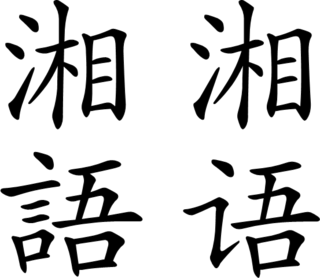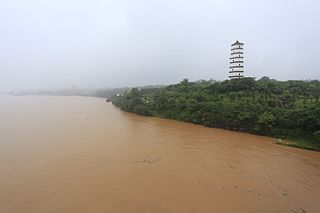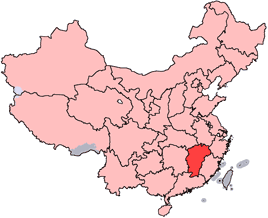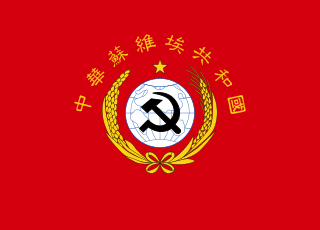
Xiang or Hsiang, also known as Hunanese, is a group of linguistically similar and historically related varieties of Chinese, spoken mainly in Hunan province but also in northern Guangxi and parts of neighboring Guizhou and Hubei provinces. Scholars divided Xiang into five subgroups, Chang-Yi, Lou-Shao, Hengzhou, Chen-Xu and Yong-Quan. Among those, Lou-shao, also known as Old Xiang, still exhibits the three-way distinction of Middle Chinese obstruents, preserving the voiced stops, fricatives, and affricates. Xiang has also been heavily influenced by Mandarin, which adjoins three of the four sides of the Xiang speaking territory, and Gan in Jiangxi Province, from where a large population immigrated to Hunan during the Ming Dynasty.

The Gan River travels 885 km (550 mi) north through the western part of Jiangxi before flowing into Lake Poyang and thence into the Yangtze River. The Xiang-Gan uplands separate it from the Xiang River of neighbouring eastern Hunan.

The Encirclement Campaign against the Northeastern Jiangxi Soviet was a campaign launched by the Chinese Nationalist Government intended to destroy the communist Chinese Soviet Republic and its local military forces. It was met by the Communists' Counter-Encirclement Campaign at Northeastern Jiangxi Soviet, also called the Counter-Encirclement Campaign at Northeastern Jiangxi Revolutionary Base. The Nationalist campaign lasted from December 1930 to July 1931, and resulted in the destruction of the target base area.

The First Encirclement Campaignagainst Jiangxi Soviet was a series of battles launched by the Chinese Nationalist Government intended to annihilate the Chinese Red Army, and destroy the Chinese Soviet Republic. The communists later responded with the First Counter-Encirclement Campaign at Central Soviet, also called by the communists as the First Counter-Encirclement Campaign at Central Revolutionary Base, in which the Red Army successfully defended the Soviet Republic in the southern Jiangxi province against Nationalist attacks from November 1930 to January 3, 1931.

The Second Encirclement Campaignagainst Jiangxi Soviet was a series of battles launched by the Chinese Nationalist Government in the hope of encircling and destroying the Jiangxi Soviet after the previous campaign had failed. The Red Army repelled the encirclement by launching their Second Counter-Encirclement Campaign, also called by the communists as the Second Counter-Encirclement Campaign at Central Revolutionary Base, in which the local Chinese Red Army successfully defended the Jiangxi Soviet against the Nationalist attacks from April 1, 1931, to May 31, 1931.

The Third Encirclement Campaignagainst Jiangxi Soviet was the third campaign launched by the Chinese Nationalist Government in the hope of destroying the Red Army in Jiangxi. It was launched less than a month after the previous campaign failed. However, this encirclement was repelled by the Red Army's Third Counter Encirclement Campaign at the Central Soviet, also called as the Third Counter-Encirclement Campaign at the Central Revolutionary Base.
The Encirclement Campaign against the Hunan-Jiangxi Soviet was a series of battles in the border region of Hunan and Jiangxi provinces initiated by the Chinese Kuomintang (Nationalist) Party / Government. The Encirclement Campaign was met by the Communists' Counter-Encirclement Campaign at Hunan-Jiangxi Soviet, also called Counter-Encirclement Campaign at Hunan-Jiangxi Revolutionary Base (湘赣革命根据地反围剿). The Hunan-Jiangxi Soviet successfully defended itself against the Nationalist attacks from January 29 to March 24, 1931.

The Encirclement Campaign against the Hunan-Hubei-Jiangxi Soviet was a campaign launched by the Right-Guomindang Nationalist Government that was intended to destroy the communist Soviet in the Hunan-Hubei-Jiangxi border region and its army. It was responded to with the Communists' Counter-Encirclement Campaign at the Hunan-Hubei-Jiangxi Soviet, also called their Counter-Encirclement Campaign at the Hunan-Hubei-Jiangxi Revolutionary Base. The local red army successfully defended this soviet republic against the government attacks from December 1930 through to May 1931.

Lianhua County is a county in the west of Jiangxi province, China, bordering Hunan province to the west. It is the southernmost county-level division of the prefecture-level city of Pingxiang.
The Northeastern Jiangxi Soviet was a constituent part of the Chinese Soviet Republic. Any military threat it posed to the Nationalist Party-controlled Chinese State (1927–1949) had been roundly neutered by an early 1931 campaign, and thus the area was never going to make a formidable component soviet of the CSR.

The Hunan–Hubei–Jiangxi Soviet was a Comintern and local communist-led liberated zone in the 1930s south of the Yangzi River, comprising parts of counties in what are now the municipal regions of Yueyang in Hunan, Xianning in Hubei and, in Jiangxi, Jiujiang and Yichun. It was a constituent part of the territorially discontiguous and diplomatically unrecognised Chinese Soviet Republic (CSR). Before the declaration of the CSR in November 1931, the liberated zone had been known to Communists as the Hunan-Hubei-Jiangxi (Xiang-E-Gan) Revolutionary Base Area (湘鄂赣革命根据地).
The Hunan–Hubei–Sichuan–Guizhou Soviet, was a revolutionary base area and constituent part of the Chinese Soviet Republic (1930–1935).

The Encirclement Campaign against Hunan-Hubei-Sichuan-Guizhou Soviet was a series of battles launched by the Chinese Nationalist Government that was intended to destroy communist Hunan-Hubei-Sichuan-Guizhou Soviet and its Chinese Red Army in the local region. It was responded by the Communists' Counter-Encirclement Campaign at Hunan-Hubei-Sichuan-Guizhou Soviet, also called by the communists as the Counter-Encirclement Campaign at Hunan-Hubei-Sichuan-Guizhou Revolutionary Base, in which the local Chinese Red Army successfully defended their soviet republic in the southern Jiangxi province against the Nationalist attacks from February, 1935 to August, 1935.
The Second Encirclement Campaign against the Honghu Soviet was a series of battles launched by the Chinese Nationalist Government that was intended to destroy communist Honghu Soviet and its Chinese Red Army in the local region. It was responded by the Communists' Second Counter-Encirclement Campaign at Honghu Soviet, also called by the communists as the Second Counter-Encirclement Campaign at Honghu Revolutionary Base, in which the local Chinese Red Army successfully defended their soviet republic in the Honghu region against the Nationalist attacks from 1 March 1931, to early June, 1931.

Pingjiang County is a county in the northeast of Hunan province, China. It is the easternmost county-level division of the prefecture-level city of Yueyang.

You County is a county in Hunan Province, China; it is under the administration of Zhuzhou City. Located on the south eastern margin of the province, the county is bordered to the north by Xiangdong District, Pingxiang City of Jiangxi, Liling City and Zhuzhou County, to the west by Hengdong County, to the south by Chaling County, to the east by Lianhua County of Jiangxi. You County covers 2,649 km2 (1,023 sq mi), as of 2015, it had a registered population of 819,845. The county has 13 towns and 4 subdistricts under its jurisdiction, the county seat is at Chunlian Subdistrict (春联街道).

The Shanghai–Kunming Railway or Hukun Railway, also known as the Hukun Line, is a major arterial railroad across eastern, south central and southwest China. It connects Shanghai, whose shorthand name is Hu, and Kunming. The line has a total length of 2,690 km and passes through Shanghai Municipality, Zhejiang, Jiangxi, Hunan, Guizhou and Yunnan Province. Major cities along route include Shanghai, Jiaxing, Hangzhou, Yiwu, Jinhua, Shangrao, Yingtan, Pingxiang, Zhuzhou, Huaihua, Kaili, Guiyang, Anshun, Qujing, and Kunming.

The Encirclement Campaign against the Hunan-Western Hubei Soviet was an encirclement campaign launched by the Chinese Nationalist Government that was intended to destroy the communist Hunan-Western Hubei Soviet and its Chinese Red Army in the local region. The Communists' responded by launching the Counter-Encirclement Campaign at Hunan-Western Hubei Soviet, also called by the communists as the Counter-Encirclement Campaign at Hunan – western Hubei Revolutionary Base, in which the Nationalist force defeated the local Chinese Red Army and overran the communist base in the southern Hubei and Hunan provinces from November 1930 to January 1931. Since the bulk of the fighting was fought at the second stage of the campaign, concentrated at the heart of the communist base, the Honghu region of Jingzhou, the campaign is therefore also frequently referred as the Fourth Encirclement Campaign against Honghu Soviet and the Fourth Counter-Encirclement Campaign at Honghu Revolutionary Base by the communists, or Fourth Counter-Encirclement Campaign at Honghu Soviet for short.

The Chinese Workers' and Peasants' Red Army, renamed Chinese People's Red Army in 1936, commonly known as the Chinese Red Army or simply the Red Army, was the armed forces of the Communist Party of China from 1928 to 1937. The Red Army was incorporated into the National Revolutionary Army as part of the Second United Front with the Kuomintang to fight against the Japanese during the Second Sino-Japanese War of 1937. In the later stages of the Chinese Civil War, they were eventually renamed the People's Liberation Army.
Zhang Huizan was a Lieutenant general in the Chinese National Revolutionary Army.












